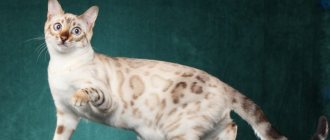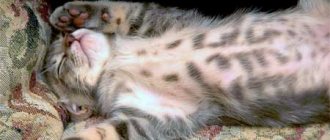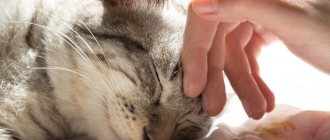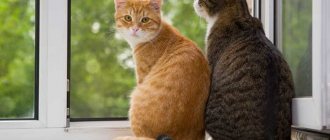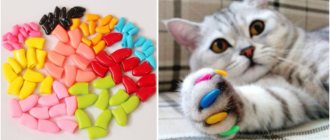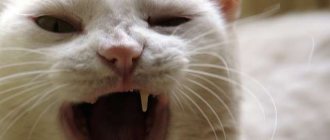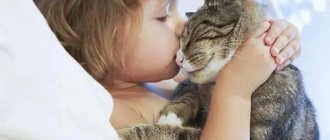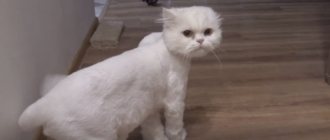Cat paws have always attracted people's attention due to the combination of softness and noiselessness of movement with sharp claws on the fingers. This found expression even in folk art. “Soft paws, with scratchy paws” - this is how the children’s riddle voices the specificity of the limbs of furry pets. But the very structure of the toes on the animal’s paws is also interesting, because cats differ in this regard from other mammals.
- 2 Anomalies in the development of fingers in cats
2.1 Video: a cat with polydactyly
Different number of fingers
Normally, a cat should have five toes on its front paws and four on its back paws. But it happens that there are six or even more of them. This is already a deviation from the norm called polydactyly. This is a genetic mutation, but it seems to help cats. They use extra fingers to improve dexterity. But normally, a cat has 5 fingers in front, 4 of which have pads, and one is located slightly to the side and does not have a pad.
The beloved woman of Alexander Gorbatov, who became his muse: photo
Situations from films from the USSR that modern youth will not understand
Mortgages with the highest rates in January were issued in Chechnya and Ingushetia
Features of walking of cats and cats
Cats are characterized by digital walking. This is probably why their gait is so silent. In addition, they place their hind paws in the place where their front paws stepped. This allows them to reduce the number of visible marks.
But these animals have another interesting feature. Cats are pacers.
Ambling is the simultaneous forward movement of the front and rear legs on one side, that is, left-left, right-right.
The peculiarity of this gait greatly increases the speed of movement and provides greater stability during sudden changes of direction.
The cat walks, moving its paws forward first on one side, then on the other.
Cats sweat through their paws
People often have sweaty palms during times of stress or just ordinary excitement. But few people know that purrs are also distinguished by their sweaty paw pads. They only sweat through them; this is the only place where they have sweat glands. This is how cats protect themselves from overheating and generally regulate their temperature. The paws should be clean and not covered with any socks or slippers (some owners like to dress their pets in them).
Functions
Cats walk on their toes like ballerinas. It is the fingers that play the main role in the movement of cats. They do not step on their entire foot, but walk “on tiptoes.” The mobility and flexibility of cat fingers allows animals to move quickly and silently, sneak up on prey unnoticed, make unexpected maneuvers and rapid jumps, which is very important for predators. The fingers are able to move separately from one another and rotate in the desired direction, which allows the cat to stay on high-risk surfaces: slippery, almost vertical, vibrating, loose, uneven.
When jumping from great heights, the toes serve as shock absorbers; elastic pads make the landing softer and safer, protecting the paws from injury. Most likely, everyone has more than once observed how cats “wash themselves” with the help of their front paws, and superstitious people associate all sorts of signs with this procedure.
In fact, cats do this solely for hygienic purposes, since these animals are clean by nature. These predators must secretly approach their prey and not give themselves away by anything - neither the sound of footsteps, nor body odor. For centuries, nature has noticed and consolidated everything that is valuable and useful for the survival of any existing species.
Sweating occurs through the paws. There are sweat glands on the fingertips. Cats sweat not only in hot weather, but also in stressful situations. The pads provide thermoregulation and prevent overheating of the body. Cats use their front fingers and claws to catch and hold prey, while their hind paws strike. Among felines, just like among people, there are “right-handed” and “left-handed,” with cats preferring the left side and cats preferring the right side. On the “priority” limb, animals have more developed fingers.
Cats walk on tiptoes
Although we think of cats' paws as feet, they are more like human toes. In all cats, the feet are located higher - under the bend of the leg. Take a closer look and you will understand everything. Cats have evolved over many millennia to learn to walk this way. This gave them an advantage in helping them survive. On tiptoe they walk much quieter and faster, which is why they have no equal in hunting and running when it comes to attacking someone dangerous.
Polydactyly in cats
We have already mentioned above that there are situations when there are more than 5 fingers on a person’s limbs. This anomaly is called polydactyly. Moreover, for example, the hand may contain both fully developed extra fingers and rudimentary, defective ones. Polydactyly also occurs in cats, when there are extra fingers on one, two, three, or all four limbs at once (even if the animal has at least one more finger than it should have normally, we can safely talk about polydactyly). By the way, unlike people, who have polyfingered fingers and feet with equal frequency, cats most often have extra fingers only on their front paws.
What are the causes of polydactylism in animals
? It's all about heredity: if either a cat or a female cat has the polydactyly gene, then with a high degree of probability (50%) at least one of their kittens will have extra toes.
How many toes can a cat with polydactyly have?
Usually 6 or 7, rarely 8. Let us remember that additional toes can be present on one foot or on all four. The maximum total number of fingers in a polydactic cat was recorded back in 1974: the animal had as many as 32 fingers instead of the usual 18!
In the old days, if a cat had more fingers than normal, people treated this fact differently:
- Norwegian sailors believed that it was polydacte cats that were much better than ordinary purrs at catching rodents on a ship. In addition, it was believed that such animals promised good luck to everyone on board, and also protected from storms and bad weather;
- In the 1750s in Europe they believed that cats with many toes were accomplices of witches. Often, innocent animals were burned along with sorcerers and witches (many of whom, like cats, were innocent);
- In the USA, for a long time, there has been a belief that stroking a many-toed cat is good luck;
- The 26th President of the United States, Theodore Roosevelt, and the American writer Ernest Hemingway had cats with abnormal limb structure. And the owners doted on their unusual tailed friends.
What to do if your cat has polydactyly
Surely every owner who notices an extra finger on their cat will want to find out whether polydactyly is dangerous. We hasten to reassure you: in the vast majority of cases, additional fingers do not interfere, and even help the animal:
- Walk comfortably on freshly fallen snow;
- Swim (provided that the pet is not afraid of water);
- Climb up trees;
- Descend from heights and jump;
- Successfully catch rodents;
- Open door and window handles;
- And even steal food from the table (although this ability is unlikely to please any owner).
It can be noted that polydactic cats look cute and funny due to their non-standard large paws. But it also happens that accessory fingers cause harm and pain to cats. Improper formation of the toes sometimes leads to the ingrowth of the claw into the soft flesh of the paw. It also happens that the extra toes are too long, so that when walking the animal constantly injures them and cannot fully walk or run. And in some situations in animals with polydactyly, the joints and bones of the limbs suffer. Therefore, if the anomaly causes inconvenience, it is better to remove additional fingers from kittens at an early age. Or at least you should not be lazy and get advice from a veterinarian on this matter. But still, in most cases, polydactic cats are absolutely healthy pets. And they do not require any treatment.
How to determine cat breed by size
Pedigree cats are divided into 2 groups based on their body type.:
- Animals with a large, rounded head , a flattened nose and a stocky body. This is the body structure of Persians and exotics.
- Animals with a wedge-shaped head , an elongated and oblong muzzle, a long graceful body and limbs. Angora, Siamese, Balinese, longhair and oriental shorthair cats fit these characteristics.
As for the weight of purebred cats, it varies from 2 to 20 kg . The body length is 40-80 cm.
Big cats
List of giant cats:
- Ashera;
- British;
- Egyptian Mau;
- Kurilian and American bobtails;
- Maine Coon;
- Norwegian Forest Cat;
- pixie bob;
- ragamuffin;
- ragdoll;
- Siberian;
- Turkish van;
- chausie;
- chito;
- Chartreuse.
Asherah
Little cats
List of miniature breeds:
- bambino;
- Dwelf;
- Kinkaloe;
- lambkin;
- munchkin;
- minuet;
- minskin;
- Singapore;
- skookum.
Lambkin
How many fingers does a British cat have? British Shorthair: Questions and Answers
Sofia Krasnoselskaya, WCF expert on all breeds of the international category, head of the Sweet Way British Shorthair cattery, answers your questions.
Dear cat owners and kitten buyers! It is important:
- A kitten up to 2-2.5 months should not leave its mother’s house! Buy a kitten from a clean home, with deworming done (that is, when the kitten was given an anthelmintic drug), with vaccinations and documents (veterinary passport and birth certificate or pedigree from the club). Only in this case can you be relatively calm about the health of your pet. The normal age for buying a kitten is 2.5 months or more.
- Before asking your question, look for a similar question and its answer in previous posts.
- All questions about the health of your pets should be directed to the vet. section Remember that sometimes it is very difficult to give an answer about diagnosis and treatment in absentia.
Experts may not answer your questions: - about the health of the kitten, if you took it from its mother prematurely, unvaccinated and without documents; - about how to feed the kitten, how much it should weigh and other questions to which answers have been given repeatedly.
Polydactyly and health
According to available information, polydactyly does not lead to serious health problems in pets, however, according to the testimony of felinologists:
- polydactyl kittens begin to walk somewhat later than their “normal” littermates, since it is more difficult for them to cope with the peculiarity of the musculoskeletal system;
- Multi-toed cats have heavier and wider bones, leading to increased body weight and increased stress on the heart and joints;
- with a large number of additional fingers and significant “branchiness” of such a structure, a pathological redistribution of the load on the limb occurs during support and movement;
- the operation to remove dewclaws is very complicated;
- an uncontrolled free claw can be dangerous.
Talisman for good luck
Legends say that those with a large number of fingers and mustaches bring happiness to their owners.
Their ancestors are considered to be Maine Coons, natives of New England, Wales and Canada. Thanks to their unique tenacious paws, they easily move through loose snow and are valued as excellent hunters. History has preserved legends that polydacts, at critical moments of hungry years, caught fish with their tenacious paws and then brought them to their owners.
For a long time they enjoyed special honor and respect among sailors who firmly believed that multi-toed cats bring unprecedented luck. The rapid spread of polydacts in America, Nova Scotia and Norway occurred, presumably, with the participation of merchant marine sailors, who carefully looked at how many fingers cats had, and selected multi-fingered ones for long journeys as travel companions. Thanks to the increased number of claws, they deftly climbed ropes, skillfully balanced on the deck during a storm, and were excellent at catching ship rats - protecting the ship's provisions from rodents.
Indications for use
The medicinal properties of cat's claw include:
- Detoxifying effects. The drug helps cleanse cells, improves liver function, helps cope with poisoning of various etiologies (alcohol, medication, poisoning by chemical emissions, etc.), and also removes excess fluid from the body.
- Immunomodulatory effects. The plant strengthens and heals the human immune system, increasing resistance to colds and infections.
- Recovery after a course of chemotherapy and radiation therapy. The drug gently and carefully restores impaired body functions, since radiation and chemotherapy are a difficult test for internal systems and organs.
- Anti-inflammatory effect. The drug helps relieve or reduce inflammatory processes in joints and internal organs.
- Antitumor effect. Cat's claw slows down the development of cancer.
- Acceleration of the healing process of ulcers. The drug promotes mild scarring of ulcers in the stomach and duodenum.
- Cardioprotective effects. The drug prevents the formation of blood clots and cholesterol “plaques” inside blood vessels, therefore it is used as a prevention of atherosclerosis. At the same time, the drug normalizes blood pressure, which is especially important for hypertensive patients.
- Antiparasitic effect. The drug has a detrimental effect on both adult parasites and their larvae.
Brain and endocrine system
Anatomically, a cat's brain is similar to the brain of any mammal.
The structure of a cat's brain is similar to that of any mammal.
Different parts of the brain are responsible for one or another function in the body:
- the parietal lobe processes information received through the senses;
- the large brain is responsible for consciousness;
- the corpus callosum connects the right and left hemispheres;
- the frontal lobe is responsible for voluntary movements;
- the olfactory bulb is responsible for the perception of smells;
- the hypothalamus secretes hormones and controls the autonomic nervous system;
- the pituitary gland coordinates and controls the work of other glands;
- the spinal cord transmits information from the brain to the body;
- the pineal gland is responsible for sleep and wakefulness;
- the cerebellum controls movements and muscle function;
- the temporal lobe is responsible for behavior and memory;
- The occipital lobe receives visual and tactile signals.
The endocrine system influences the basic functions that occur in the body with the help of hormones. Most hormones are secreted by the pituitary gland and hypothalamus. Also some of them are produced by the thyroid gland, adrenal glands, ovaries in cats and testicles in cats.
The endocrine system influences the body's basic functions
Table: hormonal regulation of cat body functions
| Hormone name | Where is it produced? | Functions |
| Antidiuretic hormone (ADH) | Hypothalamus | Urine concentration |
| Oxytocin | Hypothalamus | Labor and feeding of kittens |
| Corticoliberin | Hypothalamus | Adrenocorticotropic hormone concentration |
| Adrenocorticotropic hormone (ACTH) | Hypothalamus | The adrenal glands produce cortisol when the cat is afraid |
| Thyroid-stimulating hormone (TSH) | Pituitary | Thyroid activity |
| Melanocyte-stimulating hormone (MSH) | Pituitary | Melatonin synthesis in the pineal gland |
| Follicle stimulating hormone (FSH) | Pituitary | Production of sex hormones and eggs in females |
| Luteinizing hormone (LH) | Pituitary | Production of sex hormones and sperm in males |
| Adrenalin | Adrenal glands | Cardiac activity and dilation of blood vessels |
| Progesterone | Ovaries | Preparing the uterus for implantation of embryos, maintaining pregnancy, stimulating the development of mammary glands |
| Testosterone | Testicles, adrenal glands | Development of the cat's reproductive system, development of secondary sexual characteristics |
| Thyroxine | Thyroid | Activation of metabolism, thickening of the uterine walls, increase in heart rate |
Unique celebrity cats
Many polydactyl cats have become famous thanks to famous owners.
Theodore Roosevelt, the President of the United States, owned a polydact with the bright nickname Sleepers, who felt comfortable in the White House and even became a participant in official receptions and press conferences.
Polydacts first became known thanks to Ernest Hemingway, who, regardless of how many fingers the cats had, kept two dozen representatives of the mustachioed family on his estate. The first of these was Snowball, a gift from sea captain Stanley Dexter Hemingway. Snowball is a typical representative of six-fingered animals.
In Florida, the writer’s museum still houses dozens of cats that receive the necessary care, food, and tender care in memory of the famous author of “A Farewell to Arms” and “The Old Man and the Sea.” Some of these cats are polydacts. Perhaps these are descendants of Snowball. This cat kingdom is considered a national treasure.
Possible anomalies
Gene mutations are characteristic of all multicellular organisms, and they are also found among cats. An abnormal number of toes can occur in both male and female cats. This genetic disorder is inherited. If at least one of the parents is polydactic, then the probability of having multi-fingered offspring is very high. “Extra” toes can be on one kitten’s paw, on several, or on all four at once.
Even if there is only one “extra” toe on one leg, then this is definitely nothing more than a manifestation of the polydactyly gene. This structural feature is not considered a genetic deformity, does not affect health, and does not bring any discomfort to the animals. The only negative is that such animals cannot participate in exhibitions due to non-compliance with exhibition standards, which no one will regret if the cat is healthy, energetic and beautiful. When examining newborn kittens and discovering a “special” kitten, it is recommended to contact a felinologist and find out the prognosis for the development of the animal with the identified anomaly.
Interesting Facts
- do not see kittens with fewer toes , since they necessarily have another severe pathology in the development of internal organs, leading to death soon after birth.
- Zoological scientists are breeding a breed of cats with polydactyly - Maine Coon, they have 6 toes on their hind paws.
- When walking or running, an animal rests on only 4 fingers , no matter how many there are.
Maine Coon is a breed of cat with polydacty
“Extra fingers” are more often injured, the claws on them break and crack. This can cause the cat to become passive, lethargic, refuse to eat, and stop paying attention to its surroundings.
Therefore, it is necessary to periodically inspect the animal’s paws in order to provide assistance to it as soon as possible, if necessary.
How to cure at home
Not many people know about ways to help a pet in this situation. Do not straighten the claw or pull it out manually. This can cause harm. Take special nail clippers. Every owner should have them. Before the procedure, you need to disinfect them. Alcohol, vodka or chlorhexidine will do. Treat the area where the claw is ingrown with an antiseptic. Hold your paw firmly to prevent the cat from twitching. It's good if you have an assistant. He will fix the animal, you will carry out the procedure. Use pliers to cut off the ingrown claw down to the pink part. Blood vessels pass through there and should not be damaged. After trimming, the ingrown claw is pulled out with a sharp movement using tweezers or nippers. The procedure is painful, the animal will struggle. Therefore, it is important to do everything quickly. The cut claw is easily removed. Does not injure neighboring tissues.
Treat the wound with an antiseptic to disinfect and prevent infection. You can use furatsilin or hydrogen peroxide. Lubricate the removal site with antibacterial ointment. Cut off the rest of the claw as much as possible so that it does not touch the paw pad.
The procedure can be carried out at home in the absence of infection and inflammation of the wound. If there is redness and swelling on the soft tissues, contact your veterinarian.
The importance of maintaining healthy nails
It is important to maintain your pet’s claws in good condition, as a lot depends on it. If you don’t want your pet to spoil carpets and furniture, be sure to purchase a scratching post. This simple device can save you a lot of nerves.
In the simplest case, you can make a homemade “sharpener” by taking a small piece of wood and wrapping it tightly with rope. Why are claws so important for an animal’s health? If they grow too large, the pet will experience severe pain. Because of this, the cat will become less active, lose its appetite, and become exhausted.
Cat paw print
The print of a cat's paw is round, without traces of claws, because representatives of the family walk with retracted claws that do not touch the ground. The paws leave a mark of four toes and, no matter the hind leg or the front leg, and the metacarpal soft. The two front fingers are located in close proximity to each other, while the side ones are slightly distant from the central ones. When landing a jump, a profitable fingerprint may be left behind. When pursuing prey, the tracks of the four legs come closer together.
Similar articles:
- Cats: signs and superstitions
- How to train a cat to use a scratching post
- How to toilet train a cat
- cat claws
- Do cats love music?
- Contraception for cats
Massage
Breeders sometimes underestimate the importance of massaging their cat's paws. Regular massage prevents the deposition of salts in the joints, improves blood circulation and makes it easier for the cat to endure the nail trimming procedure.
Massaging a cat's paws is very simple; it is enough to give it 2 times a week.
Start with trusting contact with the animal. To do this, hold each paw in your hands for 3 seconds. Do this gently, and if the cat removes its paw, gently return it back.
To keep your cat's paws healthy, they need to be massaged regularly.
Then rub the top of your paw a little. Gently apply pressure on your fingers so that the cat releases its claws. This will prepare her for nail trimming. Light strokes and pressure are enough to keep your cat's paws healthy.
Paw care
Cat paws need to be looked after no matter how many toes the cat has. Due to the increased sensitivity of the paws, cats do not tolerate sharp fluctuations in temperature and pressure, react painfully to the slightest damage to the pads, suffer greatly from physical pain, eat poorly, and can become aggressive or depressed. The causes of damage can be very different. These are cuts from sharp objects while walking, thermal burns from accidentally jumping on a hot surface, chemical burns from running on snow treated with chemicals, frostbite in the cold.
All cats instinctively try to protect their paws from damage, as much as possible given the lifestyle of each animal. The owner's task is to help the pet as much as possible. Domestic cats' paws should be carefully examined every day. If there are damage, abrasions or even minor scratches, you should consult a veterinarian and treat the pads with healing agents.
In addition, microcracks and weeping ulcers on the skin of the pads can appear from improper nutrition of the animal, from severe stress or a hidden disease of the internal organs. In this case, in-depth diagnostics, comprehensive treatment and constant monitoring at the veterinary clinic will be required.
The menacing-looking claws of pets are also very sensitive, so they need to be trimmed with extreme care, without causing pain or accidental damage to the fingers, and do not allow the nails to grow too long so that they do not split. In the wild, it is enough for cats to naturally sharpen their claws on natural materials; your pet should have a high-quality scratching post.
Cat claws are an integral part of natural life. Having settled a kitten at home, you need to be prepared not only for positive emotions, but also for less pleasant surprises. For example, a pet can ruin expensive interior items with its claws, which is not its fault at all - this is the owner’s “jamb” in upbringing.
Unfortunately, some pet owners who were irresponsible about purchasing a cat quickly become fed up with problems with claws and decide to undergo surgery - onychectomy - declawing. This is a very complex procedure that only young, healthy cats can endure. Along with the claws, the phalanges of the fingers are also amputated. Many owners, depriving their pet of protective equipment, have little idea what they are dooming their pets to. With any, even the most successful result of the operation, the future life of your beloved furry will not be full.
The reduced size of the paw redistributes the load on the foot, joint displacements and arthritis develop, and the vestibular apparatus functions with disturbances for the rest of the cat’s life. A negative attitude towards such an operation is widespread among the vast majority of cat lovers and among veterinary surgeons themselves.
You can look at the six-toed cat further.
How to care for cat paws
All representatives of the cat family carefully protect their paws, because the number of paws a cat has, the number of problems it can cause. Therefore, one of the main tasks of owners is to protect their pet’s limbs as much as possible, namely:
- periodically inspect the paws;
- in case of skin injuries on pillows and fingers, it is necessary to wash and treat the wounds;
- control the growth and condition of the claws;
- If the cat does not grind its claws down on its own, you need to give it a manicure using special scissors.
If you follow these recommendations, your cat's paws will grow healthy and will not cause discomfort to your pet.
Famous multi-toed cats
Some cat lovers consider multi-toed paws cute and try to buy an unusual pet for their home, even for a lot of money. Other people associate this mutation with deformity.
The Guinness World Book of Records contains records of many unusual animals, including polydact cats. The winner in this category is still the cat with 32 toes, born in 1974 (read more about the Guinness World Records for cats). Since 2002, the championship has passed to a multi-fingered cat named Jake, who lives with Michelle and Paul Contant from the Canadian city of Ontario. The wonderful beast has 7 fingers on each paw.


